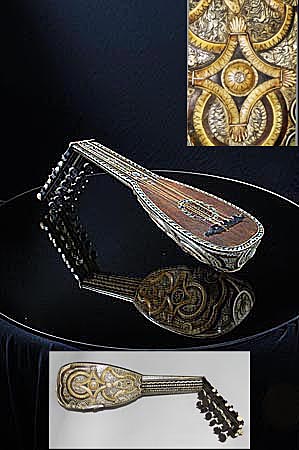
Owner: HWMC
Catalog#: CL-CHLT-38-14
Mandolins
Genoese Mandolin, 18th century
Italy
Italian
Wood, ivory, bone, gut strings, mother-of-pearl
18th century
Length: 20 in, Width: 7.25 in, Depth: 4 in
Strings – Lutes – Mandolins
During the 16th century different-sized versions of the standard lute began to appear. The six course (12-gut strings) lute called mandolino was developed in the first part of the 17th century (Baroque Period). It was a smaller version of the 16th century four-course Italian mandola and the French mandora. Music from this period also indicates that the mandolino was a 6 course (12-stringed instrument), tuned in pairs to g b e’ a’ d” g” (starting with the lowest-sounding note). This is a mandolino alla genovese, or Genoese mandolin of the 18th century.
This Genoese mandolin shows elaborate scrimshawed design inlays on its back and neck with ebony, ivory, and mother-of-pearl. Upon close inspection, numerous animals and human faces are carved throughout. It is all original with the exception of modern carved ebony tuners with ivory rings and the replacement of 12 gut strings, arranged in six double courses. This small lute has a round decorative inserted carved rosette in colored parchment. The rosette is decorated around the edges with detailed mother of pearl, as well as around the profile of the soundboard and neck. The fingerboard is flush with the spruce soundtable and there are tied-on gut frets. A bridge is glued to the soundtable, and there is no scratch-plate. The mandolin was played by plucking the strings with the fingers of the right hand. The headstock is angled back from the neck with 12 perpendicular tuning pegs.
Resource: http://www.mandolinscotland.org/mandolin/hist.html; ‘Mandolin,’ James Tyler/s; Paul Sparks/R., “The Grove Dictionary of Musical Instruments.” 2nd ed., Vol. 3. Laurence Libin, Editor-in-Chief. Oxford University Press.
